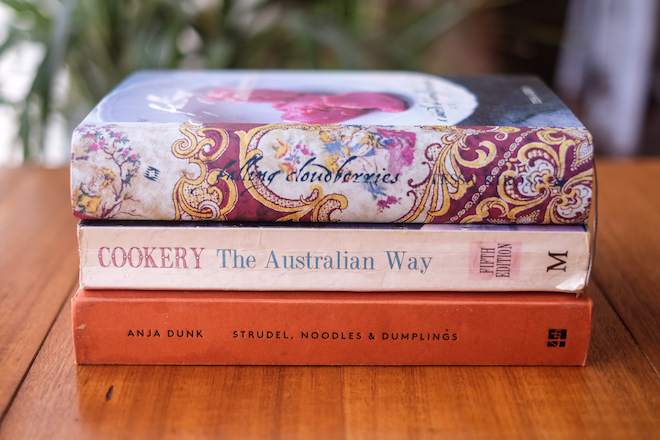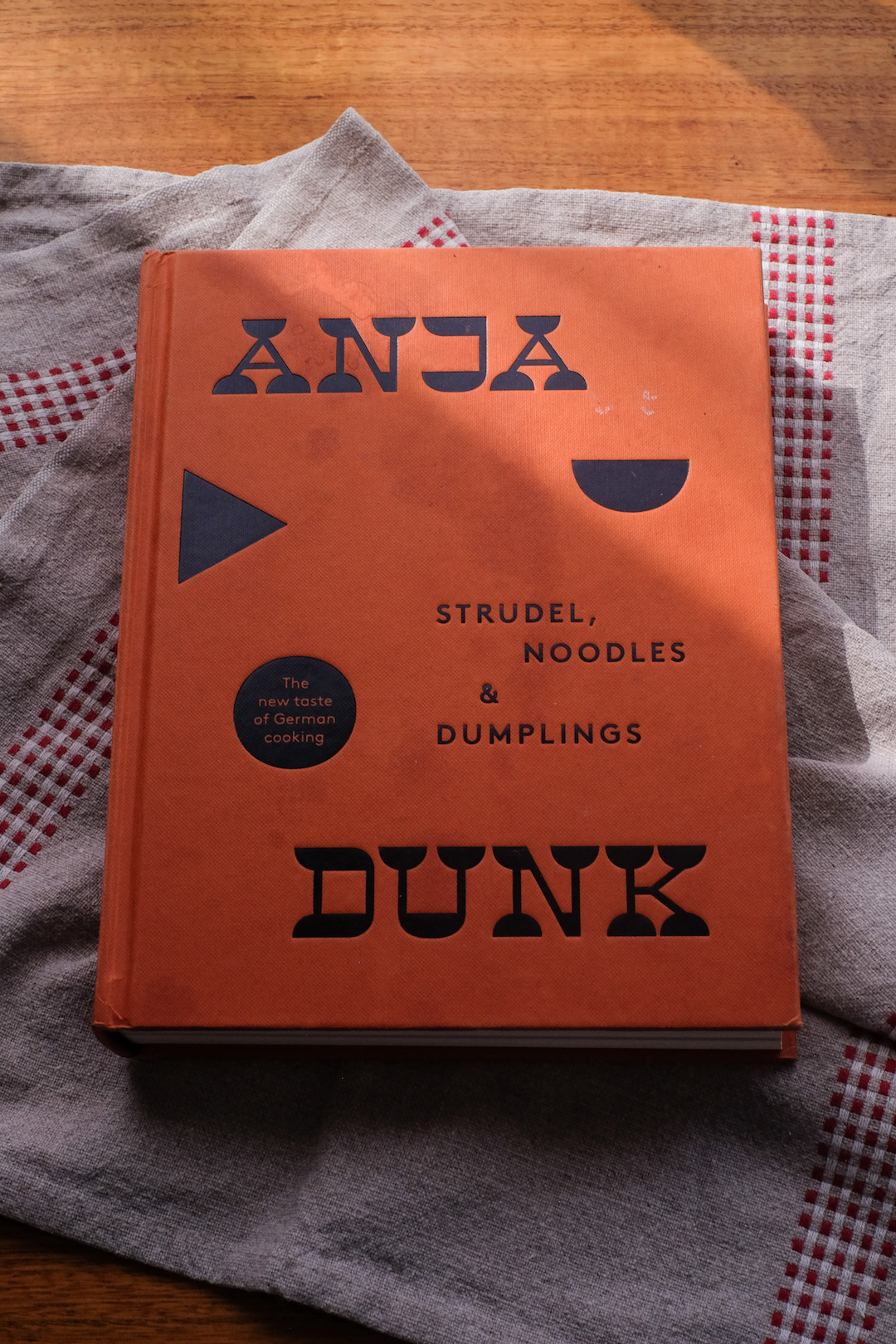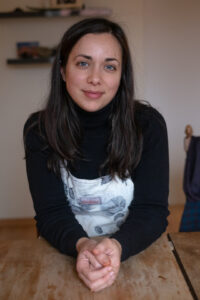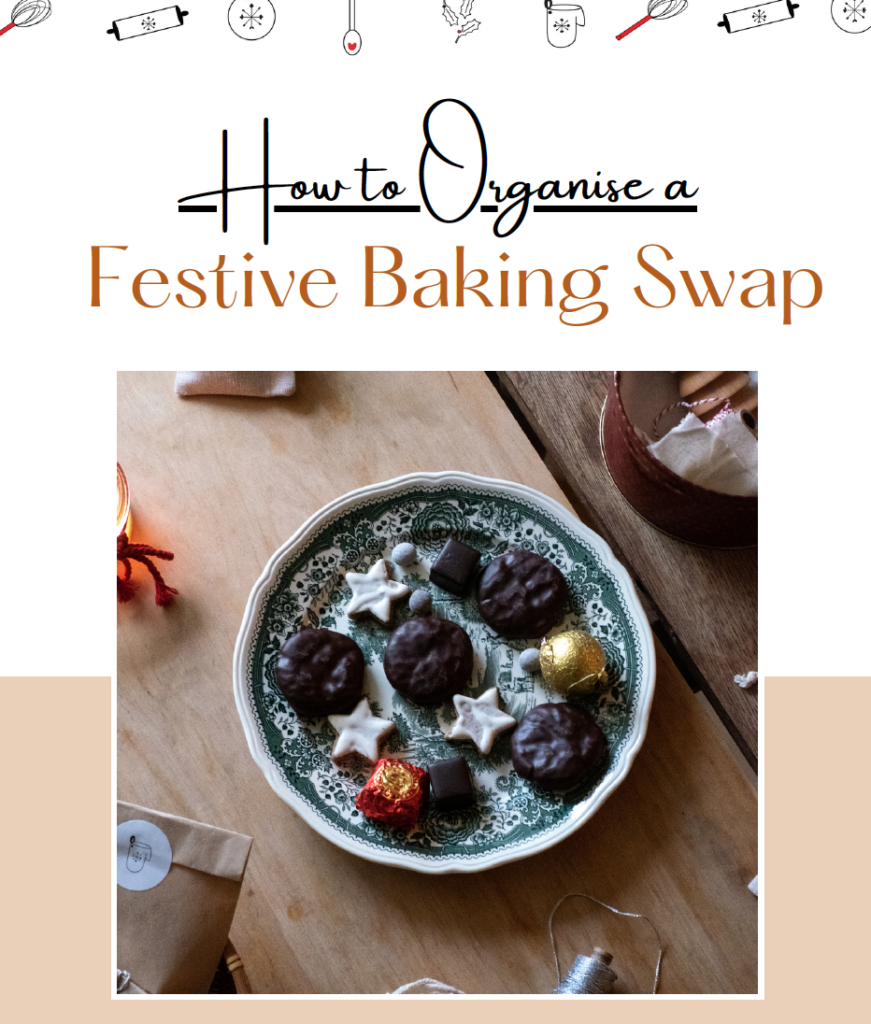My favourite cookbooks
Cookbooks for me are somewhat of a hobby and addiction. At bookstores I always make a beeline to the cookbook section as I’m always keen to see what’s been newly released or which are the bestsellers. I remember listening to a cookbook seminar online a few years ago. One of the panelists was a successful cookbook author and she mentioned a very interesting statistic, out of every cookbook (many of which average 100 recipes), only six to seven are regularly used. I found this initially quite shocking but when I looked at my cookbook collection I realised how much truth there is to that statistic.
Nonetheless, cookbooks, especially nowadays are so much more than just books to cook from, they are about inspiration, an insight into someone else’s culture and life, a way to travel (many reference this as armchair travel) and many people also talk about reading cookbooks like books and how much they belong on the bedside table as much as in the kitchen.
My current cookbook collection is currently about 60 strong. Some I’ve bought from op-shops, others I’ve received as gifts and many I research thoroughly before buying as I want to make sure I’ll get good use out of them. Here I’m sharing my favourite cookbooks and by favourite I mean the ones with not only recipes that work and that others love (as in the people I’m cooking for) but commonly my favourite cookbooks are ones that inspire, teach me something new about food and a place or people, and finally, the writer is able to connect with you in some way. This is a work in progress and I will be updated this list regularly. Below you’ll also find recommended recipes from each cookbook and the associated pages.
For press enquiries regarding cookbooks, or cookbook questions, please contact me via this form.
Cookery the Australian Way (5th edition)
By Shirley Cameron, Suzanne Russel and Winifred Williams
Cookery the Australian Way is the first cookbook I ever owned (it was required for our Home Economics class in year 9). 25 years later, it still remains one of the most used cookbooks in my collection. During Home Economics class that year, I remember using the book to make two dishes in particular: spaghetti bolognese and the egg sponge. Everything we made we got to take home and I’ll never forget my Mum’s reaction when she saw the light, moist egg sponge. She was both impressed and in disbelief that a 14 year old had made it (with my teacher’s assistance of course!). To this day it is still my go-to sponge recipe – it works every time.
Beyond the seemingly dated cover, what I love about this cookbook is the sheer amount of classic recipes and surprising collection of international recipes for a book originally released in the 60s (think borsch, gado gado and Greek egg soup). Across 458 pages (index included) there are 18 chapters that cover diet and nutrition, kitchen management to starters and snacks, vegetarian dishes to meat and poultry, salads, and an extensive sweets and baked section (think pastry, scones and muffins, biscuits and slices and even cake icing and decorating). Apart from the egg sponge (pg 348), the recipes I return to the most are the sausage rolls (pg 209), the drop scones (pg 332), the apple crumble (pg 290), the mint sauce (pg 180) and the small sponge cakes (pg 349) which I use for butterfly cakes. Every time I am stuck with a way to cook an ingredient I always turn to this book for recommendations and advice, it rarely fails to deliver what I am looking for.
Cookery the Australian Way is available online at selected bookstores and also direct through Home Economics Victoria.
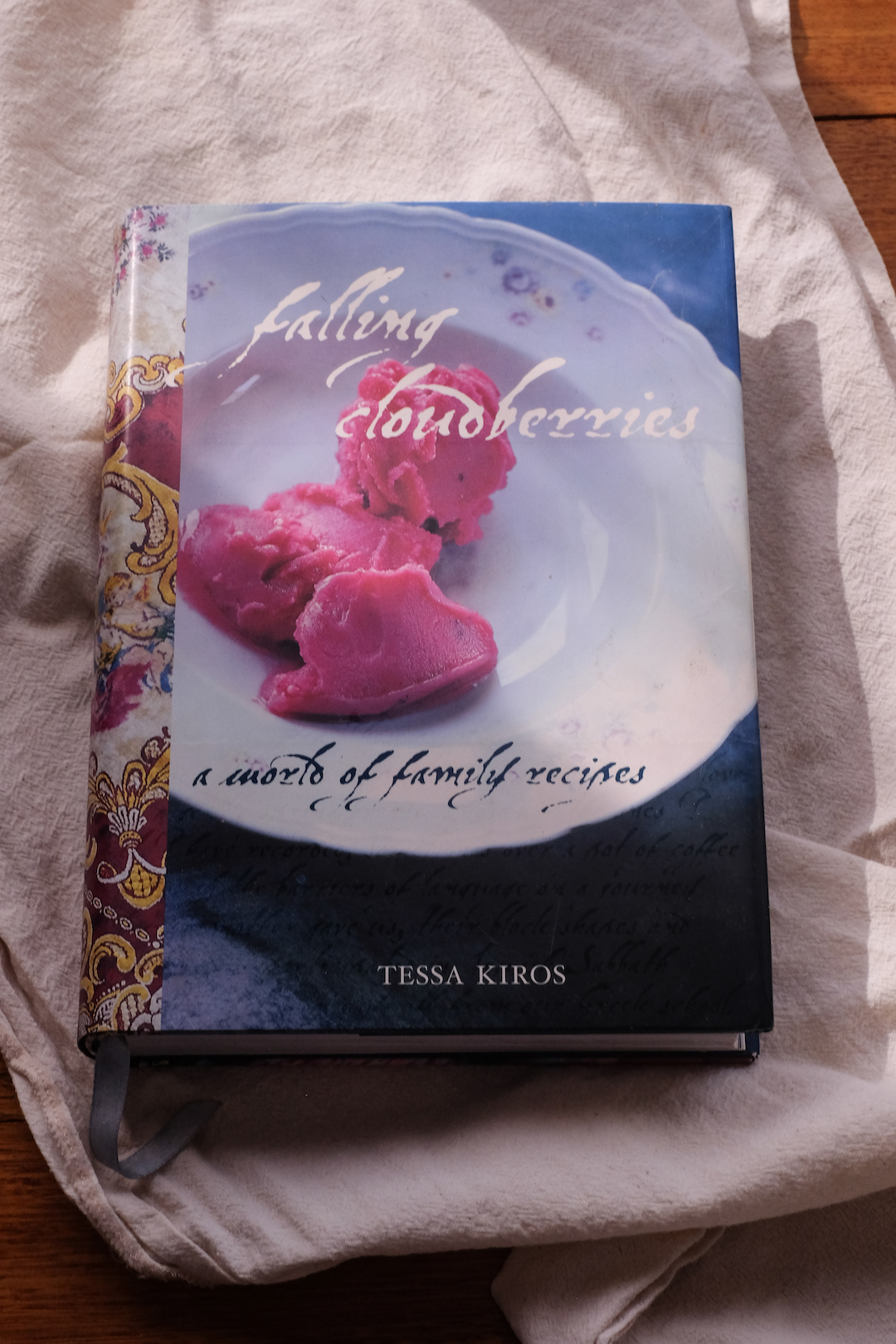
Falling Cloudberries
by Tessa Kiros
A few years passed between owning my first cookbook in year nine to my next adult cookbook when I had just started University. Falling Cloudberries was gifted to me by a family friend. At the time I babysat her children, house-sat and even dog-sat for her family as they were frequent travellers. I received Falling Cloudberries for Christmas from her one year and it persists to be yet another book I simply cannot part with. Tessa’s cookbook is one that goes beyond the strict cookbook format. Instead, Falling Cloudberries indeed like all Tessa’s books is a world that you can access through its pages. It’s an Alice in Wonderland cookbook daydream that sends you to far away places from the comfort of your home and kitchen while you soak in the terrains and memories shared through flavours, smells and the people central to the dishes. Tessa has a rich mix of heritages and weaves them all so beautifully into the following chapters over 397 pages comprising the index: Falling Cloudberries (Finland), Oregano, Oranges and Olive Groves (Greece), Cinnamon and Roses (Cyprus), Monkey’s Weddings (South Africa), Washing Lines and Wishing Wells (Italy) and Suitcase of Recipes (World).
This book took on new meaning for me when I met my husband as he is half Finnish and I am Italian, so some of Tessa’s worlds connected to mine. I love the Finnish meatballs with allspice, sour cream and lingonberries (pg 33), the oven-cooked potatoes with onions and cream (pg 57) are just divine, Sipi’s Strawberry Cake is a wonderful festive cake (pg 61), in the Greece chapter I love the Skordalia (pg 94), the baked butter beans with onions, tomatoes and parsley (pg 121). Travelling to Cyprus the fried red peppers (pg 155) are worth the effort. In South Africa Bobba’s Babka (pg 246-7) is a delicious treat, while Sue’s rusks (pg 275) make a huge batch of these sweet, crunchy biscuits perfect to have at the ready when a little sugar craving hits.
If you love armchair travel, learning about different places and cooking flavoursome, time-honoured recipes, Falling Cloudberries will not disappoint. It’s fantastic for recipes when you’re hosting a dinner party or want to put a special family meal together.Despite owning it for almost 20 years, its contents never gets old and I am often rediscovering its pages. Just the other day I made the carrot cake (pg 259) for the first time and it was perfect.
(Tessa has kindly shared her prawns with feta recipe from Falling Cloudberries, as well as her sweet potato cake) from her Provence to Pondicherry cookbook.
Strudel, Noodles and Dumplings
by Anja Dunk
This cookbook has got to be the one I recommend most to people looking for foolproof, hearty and flavourful family friendly recipes. Though it’s not marketed as a family cookbook and rather a cookbook on modern German cuisine, in Strudel, Noodles and Dumplings, Anja has a repetoire of recipes that make quantities large enough to share, and with flavours palatable to young children.
This book was released when I was living in Germany so it was a wonderful companion during that time as it made me feel more connected to my surroundings and the food culture. It’s no secret that German food has a negative stigma. Words like ‘fatty’ or ‘stodgy’ and ingredients like potato and cabbage are common expectations of what I believe is a cuisine that is very misunderstood and misrepresented outside of its country (and dare I say, even within it!).
What most people don’t know about German cuisine is how connected it is to vegetables and the seasons. At farmer’s markets in the spring you will see Germans queuing up for spargel (asparagus) and nine times out of ten it will be for the prized white varietal. In summer strawberry huts are set up on the streets (often near high traffic areas) and sell strawberries, even raspberries, blueberries and sometimes potatoes and asparagus too – all from local farms. In Autumn the pfefferlinge arrive, also known as chantarelle mushrooms and in winter there is the beloved local kale, and towards the end of the season wild garlic or ramps. These are mere examples of a myriad of fresh ingredients Germans adore and use in their cuisine, the opposite of the meaty, sausage laden fare they seem to be known by.
In Anja’s book, you’ll find recipes from across some of Germany’s 16 states, that demonstrates the breadth of their cuisine, especially ways with vegetables. Her recipes are fool proof (she’s cooked in kitchens and worked as a recipe tester) and many are time-honoured, passed down from her mother and grandparents.
Her savoury quark fritters recipe with honey and thyme salt (pg 26) is a wonderful treat. The onion tart (zwiebelkuchen, pg 84) is a must-try, classic German dish. If you’re a fan of rye sourdough then I highly recommend trying Anja’s rye bread starter (pg 91) and her everyday sourdough with rye and wheat flour recipe (pg 94). Continuing with the rye theme, her rye and buttermilk crackers (pg 101) are wonderful and simple to put together. From her soups and stews chapter, I adore the parsley soup (pg 112), it’s so comforting and parsley is such an unexpected hero ingredient.
I should also mention that if you like having a pantry full of homemade staples, this is just another reason why this book is such a wonderful cooking companion. Whether you’re interested in bottling preserves or making fresh quark or yoghurt, Anja has you covered. What became a staple baking ingredient in our kitchen was her cinnamon sugar (pg 207) and the vanilla sugar (pg 217). During the week her chicken with elderflower (pg 230) became an easy, quick and satisying meal option. For a quintessential German comfort dish, I highly recommend the creamy apples and potatoes (pg 237). On page 254 you’ll find the recipe for whole baked trout with leeks and potatoes – another fast and flavoursome mid-week meal. Finally for sweets, her speedy apple cake (pg 278), based on the one her Mother would make for her and her brother growing up, will no doubt become a go-to for future afternoon teas. As you can see, this is one of my favourite cookbooks for good reason.
(Anja kindly shares to of her recipes on the site. Be sure to try her potato and parsley soup and her speedy apple cake)
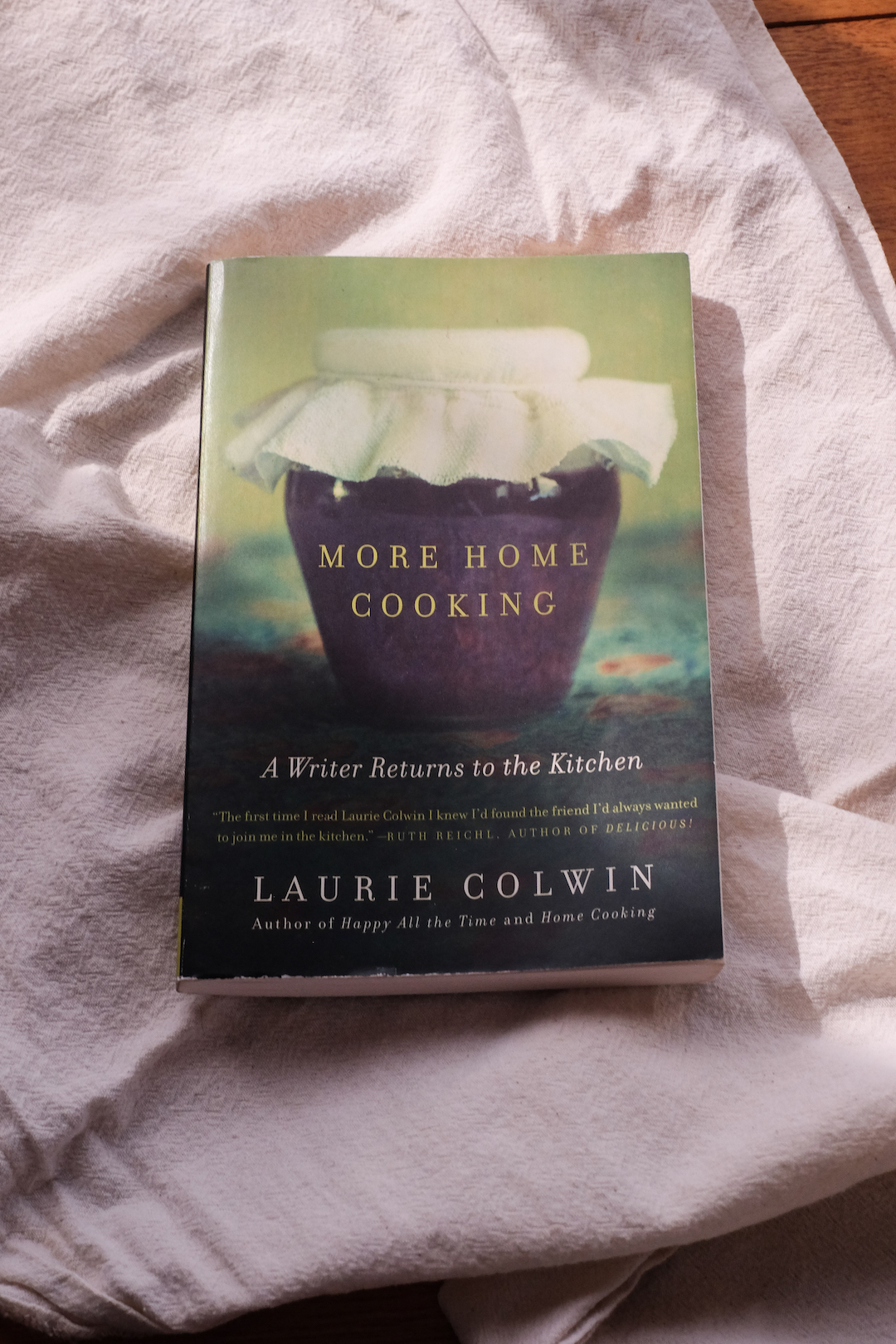
More Home Cooking: A Writer Returns to the Kitchen
by Laurie Colwin
Although it’s not exactly a cookbook, More Home Cooking by Laurie Colwin is a mix of culinary focused essays and recipes. She also wrote Home Cooking (another fantastic collection of food essays) which preceded More Home Cooking.
First of all it’s important to note that Colwin is an excellent, clear and succinct writer who not only lures her reader but seems to invite them in to her world. You instantly feel something familiar, comforting and relatable in her writing until you are reading More Home Cooking like a novel. She sounds direct and honest but at the same time is completely likable and dependable, and the recipes she includes at the end of almost each essay in this book are exactly that, dependable. Some of the essays have wonderful and alluring titles like The Duck Dilemma, Jam Anxiety and The Case of the Mysterious Flatbread. Within these she shares anecdotes, provides suggestions and solutions to quell the specific food problem at hand.
One of my favourite essays is the one named More About Gingerbread, where she provides two wonderful recipes. The Damp Gingerbread (pg 69) is my favourite, and has such a moist and tender crumb and inevitably smells like Christmas no matter what time of year you bake it. Then there’s the Four Easy Pieces essay which includes a number of invaluable, child-friendly recipes. I love the recipe for Scotch broth soup (pg 138), and my daughter loves (surprisingly to me) the vegetarian chili (pg 139), the latter is unbelievably simple to put together.
I continue to return to this book not only for Colwin’s engaging insights and stories and recipes but for her palate and trustworthy recipe recommendations. She somehow feels/reads like someone I know but have never met. I highly recommend this book (221 pages total) and Home Cooking.

It’s All Good
by Gwyneth Paltrow and Julia Turshen
I am well aware that Gwyneth Paltrow’s name encourages raises of eyebrows and general division and controversy. Despite that, I will say that her cookbook It’s All Good is honestly one of the most dog-eared cookbooks in my entire collection. Paltrow and Julia Turshen, the co-author of the book, have indeed put together a collection of ‘delicious, easy recipes’ (as promised on the cover page) but for me this book is more than that. Though overall the recipes lean towards cleaner and substitute ingredients for gluten (special flours and xantham gum), the recipes are always flavour packed.
The cuisine styles featured are also a real mix from Asian influences to Mediterranean and Middle Eastern. The chapters include stocking your pantry, breakfast, salads and dressings, soups, birds/meat, fish, vegetables, grains, drinks, recipes for kids, dessert and basic recipes, as well as sample menu ideas (which is a feature I love in cookbooks).
One of my favourite recipes is the sweet potato and five spice muffins (pg 41) – very popular with my children and as a sweet snack for adults. Though it’s one of the more complicated recipes in the book, the two-pan chicken with harissa, preserved lemons and green olives (pg 112) comes out beautifully. The carrots with black sesame and ginger make a lovely side dish (pg 161), as do the white beans French style (pg 164). Another lovely dish is the super-healthy kosheri (p 179), and though it seems simple, the stir-fried brown rice with nori and black sesame (pg 195) is beautifully flavoured and comforting dish. I love a kids section in a cookbook and the one in It’s All Good is a fairly interesting one because of the not immediately kid-friendly flavours like ginger, mustard and cabbage for example, however like always, there are some winners. The Vegan Shepherd’s Pie (pg240) my children eat willingly and Camerino’s Popcorn (p243) – simply popcorn, salt and olive oil but with a terrific method – so far has been foolproof. I’ll be honest, the dessert chapter is the section I’ve used the least but my children love the colourful Frozen Pops (pg 265), a combination of blitzed frozen berries with coconut and maple syrup.
I highly recommend this cookbook especially readers that prefer ‘healthier’ or ‘cleaner’ ingredients in their diet.
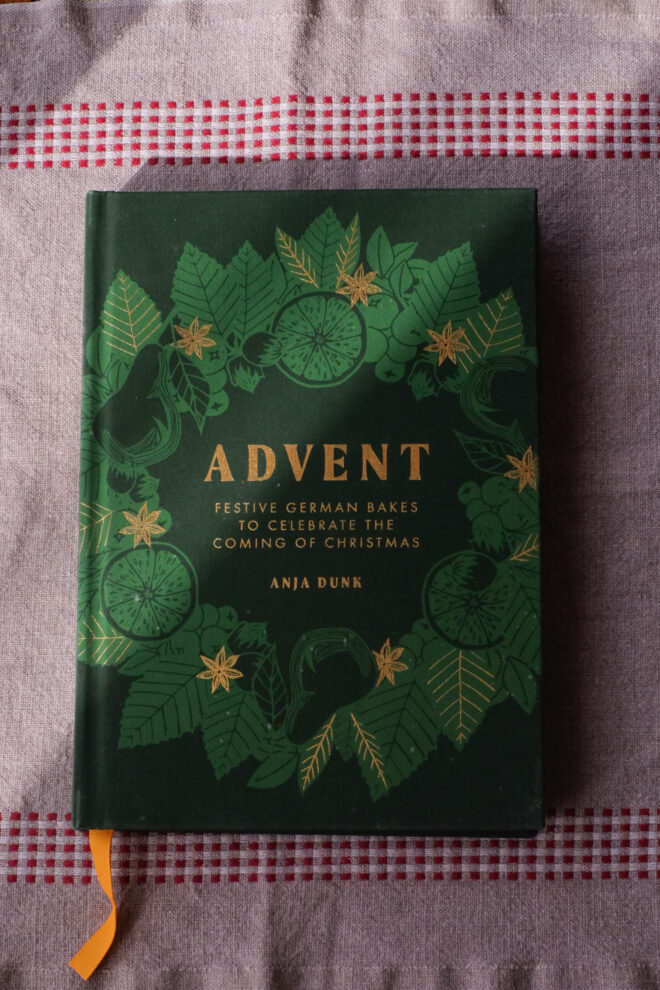
Advent: Festive German Bakes to Celebrate the Coming of Christmas
By Anja Dunk
For the Christmas and festive lovers out there, Advent by Anja Dunk has got to be one of the most wonderful new books on this topic out there. This unique cookbook is numbered into 24 chapters, with each one zoning in on a specific baking tradition. There’s an entire chapter dedicated to gingerbread (lebkuchen), Christmas market food, chocolate biscuits, sweets made with marzipan, even festive drinks. If I were to recommend one Christmas baking or simply Christmas cookbook, it would without a doubt be this one. In addition, the book is beautifully presented both inside and out with stunning photography and close-ups of the biscuits, as well as 24 incredible linocut illustrations by Anja.
In terms of recipes I highly recommend the Lebkuchen hearts on page 29. With some fairly easy to find ingredients and a heart shaped cookie cutter you’ll create some wonderfully delicious German gingerbread. The chocolate and ginger biscotti on page 59 are lovely and very adaptable to ingredient changes. For the Stollen lovers of which there are many (I’m sadly not one of them) there is a very nice chapter on this famous Christmas bread with five recipes including Stollen biscuits and bites. Anyone who’s tried to make black and white cookies or chocolate and vanilla shortbreads (pg 138 -9) as Anja calls them, knows they can be quite tricky. Conscientiously, Anja provides a few adaptations to create them including easier versions. These are particularly delicious and are amongst my most coveted biscuits in our recent Christmas baking collections the last two years. Finally, an extremely special recipe are Anja’s spiced chocolate hearts on page 143. I would recommend doubling the batch of these Swiss biscuits as they are just too delicious – chewy, chocolatey delights.
I love Anja’s work and when you open her books the level of creativity in her work is astounding. I also love knowing I can rely on the guidance of her written voice and the accuracy in her recipes. Advent will without a doubt become a cookbook you come to treasure in your Christmas and cookbook collection.
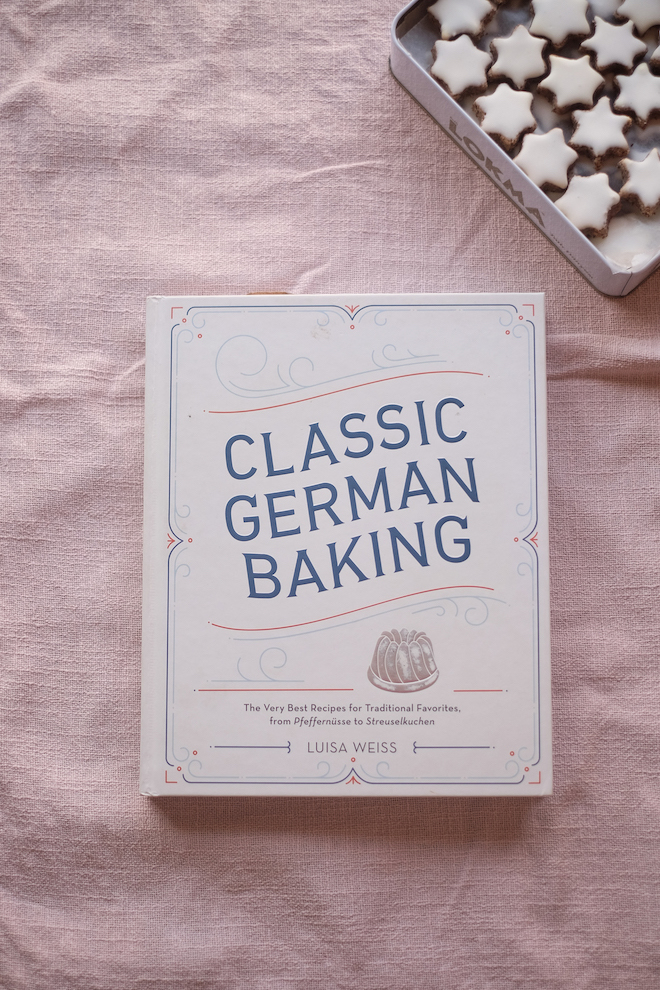
Classic German Baking
by Luisa Weiss
This cookbook by Luisa Weiss has a cult-like following. Every year from the start of October until Christmas I see a jump in recipe posts from Weiss’ Classic German Baking in my Instagram feed and for good reason.
Though the book isn’t intentionally festive, it does have a particularly extensive chapter on Christmas favourites. For anyone who has any German heritage or links to German culture or baking for that matter then you’ll know that Christmas baking is a ‘thing’. Specifically, baking for Advent. In what would have been an incredibly challenging task, Weiss was able to distill this chapter to some real classics and several of these recipes are my go-to each year around Christmas. First of all I highly recommend the recipe on page 218 for lebkuchen (old-fashioned German gingerbread). In this particular version, the recipe is recommended to be made at the start of October so it can ripen for a few months before being rolled out closer to Christmas. This aging of sorts, lends a very distinctive and special flavour to the dough and I highly recommend it. Zimtsterne (cinnamon stars) on page 241 are another favourite, and for the last few years I’ve only used Weiss’ recipe. It’s simple to put together and very straight forward. In this chapter Weiss also includes recipes for one of my favourite German festive sweets, Baumkuchen (literally translates to ‘tree cake’) on pg 259, as well as two types of Stollen – pages 256 and 257, traditional vanilla almond crescents pg 248, simple Christmas cookies (perfect for kids to make) on pg 246, and the very special springerle (Swabian anise cookies) on pg 231.
Other chapters include cookies, cakes, yeasted cakes (my favourite!), tortes and strudels, savories, breads and rolls, and a chapter on basics which includes recipes for Lebkuchen spice mix and vanilla sugar.
I’m particularly a fan of the roasted squash bread on pg 204 (divine and a seasonal offering in Germany) and the savoury onion cake (another seasonal classic) on pg 152.
If you’re an avid baker, Classic German Baking is a wonderful baking companion not just at Christmastime but also throughout the year.
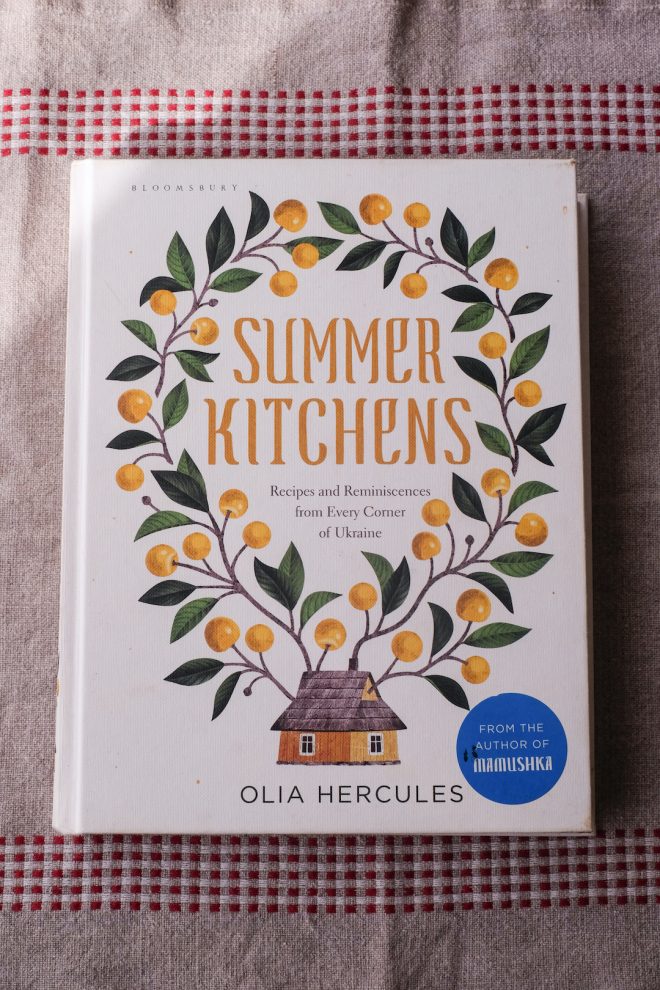
Summer Kitchens: Recipes and Reminisces from every corner of Ukraine
by Olia Hercules
Summer Kitchens was actually the first book I’d ever pre-ordered. I was so intrigued by the recipes teased out by Olia during the pre-order campaign that I just couldn’t wait to get a copy. Originally the idea for Summer Kitchens was intended for an article, but became so much more. Summer kitchens are outside spaces or structures, separate to a kitchen in a house used to prepare food mainly in the summertime. According to Olia in her cookbook, summer kitchens were also used “to prepare bigger feasts in winter..especially during festivities.”
Olia’s cookbook not only explores this fascinating cooking space phenomena, but she also seeks to capture the recipes cooked in these kitchens from all over Ukraine. During her research for the book, over 50 people reached out to Olia to share their summer kitchen stories, even beyond Ukraine. As a result, a handful of these letters feature in a beautiful section at the end of the book called Summer Kitchen memories.
Summer Kitchens features seven in-depth chapters. The first covers fermenting, pickling and preserving, followed by breakfast and bites, broths and soups, bread, pasta and dumplings, vegetables, meat and fish, and ends on a sweet note with cakes, desserts and pastries.
In terms of the recipes I have to start with the recipe that is on the highest rotation in our home, the ‘rock and roll’ pancakes on page 86. This is our go-to pancake recipe, that is more of a crepe than the ‘fluffy’ type of pancake. The most interesting details about this recipe include the use of boiling water in the batter, and my favourite: the pack of unsalted butter (yes the whole block) which is recommended to use to lather onto the pancakes. I also love the pancakes with mushroom and chicken, little savoury parcels of joy on page 88, which use the aforementioned pancake recipe. The biggest recipe revelation for me in the book is lyok dressing – a punchy garlic and herb paste which features in a recipe with courgettes (zucchini) on page 210. Here discs of the courgettes are pan-fried then drizzled with an incredible lyok dressing of herbs, garlic, vinegar, honey and salt and pepper – this is a standout for me. Finally, there is the curd cake with caramelised apples on page 286. If you love apple and cheesecake style cakes, then this is for you. I love that the apples are fried in brown sugar first to caramelise them, and then are laid out at the bottom of the pan so when it’s topped with the curd, baked and turned out they sit beautifully compact at the top.
Summer Kitchens is full of exciting recipes, each like an experience of sorts. If you have Ukrainian friends, this is wonderful gift, and likewise for anyone that loves to explore the world through food – this would be a cherished present. It is also quite simply a thoughtful and meaningful book that has increased in cultural significance and value as it was published in 2020 just two years prior to the current war.
More cookbook reviews coming soon!
For press enquiries regarding cookbooks, or cookbook questions, please contact me via this form.


